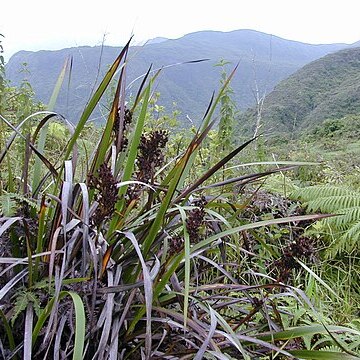Herbs, perennial, often with long scaly rhizomes. Culms tufted, erect, flattened, angular, or terete, usually smooth, rarely rough. Leaves distichous; basal sheaths brown to purplish; ligule absent; leaf blade unifacial, compressed or terete, sometimes reduced to a sheath. Involucral bracts sheathing and with a short blade. Inflorescences paniculate, consisting of few to several partial panicles, main axis often sinuous. Spikelets often clustered, rarely solitary, ovoid to narrowly ovoid, compressed. Glumes distichous, basal 1 or 2 flowers bisexual, apical flower(s) male. Perianth bristles absent. Stamens 3. Style base distinctly thickened, conic or pyramidal, persistent; stigmas 3. Nutlet stipitate or sessile, ovoid, oblong, or oblong-ellipsoid, ± terete or 3-sided, smooth or rugulose, apex beaked.
Rhizomatous perennials. Leaves mainly basal, a few cauline, laterally compressed, distichous, equitant at base. Culms tufted, pithy; inflorescence paniculate, of several partial panicles. Spikelets numerous, clustered, persistent, ovate to lanceolate, compressed. Glumes distichous; lowest 1–4 glumes empty, smaller than those bearing nuts; upper ones small, with staminate flowers or empty. Flowers bisexual and male. Hypogynous bristles absent or 3–6. Stamens 3. Style 3-fid. Nut ovoid–ellipsoidal, 3-sided or terete, usually long stipitate, usually 3-winged, crowned by style base, naked.
Infl. an effuse often drooping panicle. Spikelets , 2–6-fld, 2–4 lowest fls setting fr. Glumes obscurely distichous to spiral. Hypog. bristles 6–3, or 0 (in N.Z. sp. 0). Stamens 3. Style-branches 3, style-base ± 3-winged or sharply 3-angled. Fr. with very thin brittle pericarp at maturity and a ± 3-winged us. long stipe, crowned by the persistent conspicuous style-base. Perennial herbs. Lvs us. basal, strongly laterally compressed, distichous, equitant at the base. Some 25 spp. from the West Indies, S. America, Hawaii, Malesia and the Pacific Is; one N.Z. sp.

